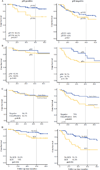Detailed Analysis of Clinicopathologic Factors Demonstrate Distinct Difference in Outcome and Prognostic Factors Between Surgically Treated HPV-Positive and Negative Oropharyngeal Cancer
- PMID: 25801358
- PMCID: PMC4986601
- DOI: 10.1245/s10434-015-4525-0
Detailed Analysis of Clinicopathologic Factors Demonstrate Distinct Difference in Outcome and Prognostic Factors Between Surgically Treated HPV-Positive and Negative Oropharyngeal Cancer
Abstract
Background: Oropharyngeal cancers (OPC) secondary to human papillomavirus (HPV) infections likely represent a completely different disease compared with conventional head and neck cancers. Our objective was to analyze a surgically treated cohort to determine predictors of outcome in HPV-positive versus HPV-negative patients.
Methods: HPV positivity was inferred based on p16-immunohistochemistry. Data was available for 201 patients with OPC treated with surgical resection with/without adjuvant radiotherapy between 1985 and 2005. Subsite distribution was: 66 (33 %) tonsil, 46 (23 %) soft palate, and 89 (44 %) tongue base. Patients were classified into low-, intermediate-, and high-risk groups based on p16 status and smoking history. Outcomes stratified by p16 status and risk groups were determined by the Kaplan-Meier method. Factors predictive of outcome were determined by univariate and multivariate analyses.
Results: In this cohort, 30 % had locally advanced disease (pT3/T4) and 71 % had nodal metastasis. The 5-year overall (OS), disease-specific, and recurrence-free survival rates were 60, 76, and 66 %, respectively. There were 22 % low-, 34 % intermediate-, and 44 % high-risk patients. Patients who were p16-positive had better survival compared with p16-negative (OS, 74 vs. 44 %; p < .001). Similarly, low-risk group patients had a better survival compared with intermediate- and high-risk groups (OS, 76, 68, 45 %, respectively, p < .001). Independent predictors of survival in p16-negative patients included margin status, lymphovascular invasion, pN status, and extracapsular spread. In contrast, none of these were predictive in p16-positive patients.
Conclusions: Surgically treated patients with p16-positive OPC have superior survival compared with p16-negative patients. Outcomes in p16-positive and p16-negative OPC are determined by different prognostic factors supporting the notion that these are very different diseases. These should be incorporated into future clinical trials design.
Figures


Similar articles
-
Histopathological Prognostic Factors of Surgically Treated HPV-Associated Oropharyngeal Squamous Cell Carcinoma: A Systematic Review and Meta-analysis.Ann Surg Oncol. 2025 Feb;32(2):1280-1300. doi: 10.1245/s10434-024-16362-x. Epub 2024 Nov 2. Ann Surg Oncol. 2025. PMID: 39487900
-
Prognostic factors and survival unique to surgically treated p16+ oropharyngeal cancer.Laryngoscope. 2012 Sep;122 Suppl 2:S13-33. doi: 10.1002/lary.23493. Laryngoscope. 2012. PMID: 22926949
-
Ki67 Expression has Prognostic Significance in Relation to Human Papillomavirus Status in Oropharyngeal Squamous Cell Carcinoma.Ann Surg Oncol. 2015;22(6):1893-900. doi: 10.1245/s10434-014-4237-x. Epub 2014 Nov 18. Ann Surg Oncol. 2015. PMID: 25404475
-
T-category remains an important prognostic factor for oropharyngeal carcinoma in the era of human papillomavirus.Clin Oncol (R Coll Radiol). 2014 Oct;26(10):643-7. doi: 10.1016/j.clon.2014.06.007. Epub 2014 Jul 4. Clin Oncol (R Coll Radiol). 2014. PMID: 25001635
-
[HPV infection in head and neck squamous cell carcinoma (HNSCC). Highlights from ASCO 2010].HNO. 2010 Dec;58(12):1163-7. doi: 10.1007/s00106-010-2200-0. HNO. 2010. PMID: 20963389 Review. German.
Cited by
-
Identification of prognostic molecular biomarkers in 157 HPV-positive and HPV-negative squamous cell carcinomas of the oropharynx.Int J Cancer. 2019 Dec 1;145(11):3152-3162. doi: 10.1002/ijc.32412. Epub 2019 May 30. Int J Cancer. 2019. PMID: 31093971 Free PMC article.
-
Histopathological Prognostic Factors of Surgically Treated HPV-Associated Oropharyngeal Squamous Cell Carcinoma: A Systematic Review and Meta-analysis.Ann Surg Oncol. 2025 Feb;32(2):1280-1300. doi: 10.1245/s10434-024-16362-x. Epub 2024 Nov 2. Ann Surg Oncol. 2025. PMID: 39487900
-
Treatment Outcomes of Squamous Cell Carcinoma of the Soft Palate and the Prognostic Significance of HPV/p16 Status.Head Neck. 2025 Aug;47(8):2248-2259. doi: 10.1002/hed.28143. Epub 2025 Mar 27. Head Neck. 2025. PMID: 40145145 Free PMC article.
-
Neutrophil to lymphocyte ratio is an independent prognostic factor in patients with recurrent or metastatic head and neck squamous cell cancer.Mol Clin Oncol. 2015 Jul;3(4):839-842. doi: 10.3892/mco.2015.557. Epub 2015 May 4. Mol Clin Oncol. 2015. PMID: 26171192 Free PMC article.
-
Validation and assessment of discordance of the 8th edition AJCC (American Joint Committee on Cancer) clinical and pathologic staging systems in patients with p16+ oropharyngeal cancer treated with surgery and adjuvant radiation at a single institution.Oral Oncol. 2018 Aug;83:140-146. doi: 10.1016/j.oraloncology.2018.06.024. Epub 2018 Jun 23. Oral Oncol. 2018. PMID: 30098770 Free PMC article. No abstract available.
References
-
- Kreimer AR, Clifford GM, Boyle P, Franceschi S. Human papillomavirus types in head and neck squamous cell carcinomas worldwide: a systematic review. Cancer Epidemiol Biomarkers Prev. 2005;14:467–475. - PubMed
-
- Sturgis EM, Cinciripini PM. Trends in head and neck cancer incidence in relation to smoking prevalence: an emerging epidemic of human papillomavirus-associated cancers? Cancer. 2007;110:1429–1435. - PubMed
-
- Gillison ML, Koch WM, Capone RB, et al. Evidence for a causal association between human papillomavirus and a subset of head and neck cancers. J Natl Cancer Inst. 2000;92:709–720. - PubMed
Publication types
MeSH terms
Grants and funding
LinkOut - more resources
Full Text Sources
Other Literature Sources

